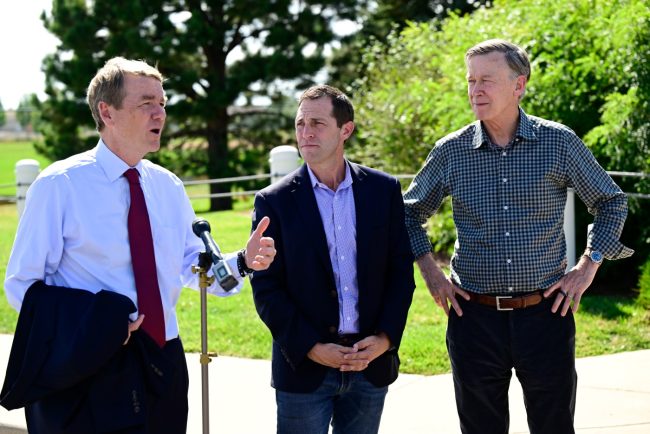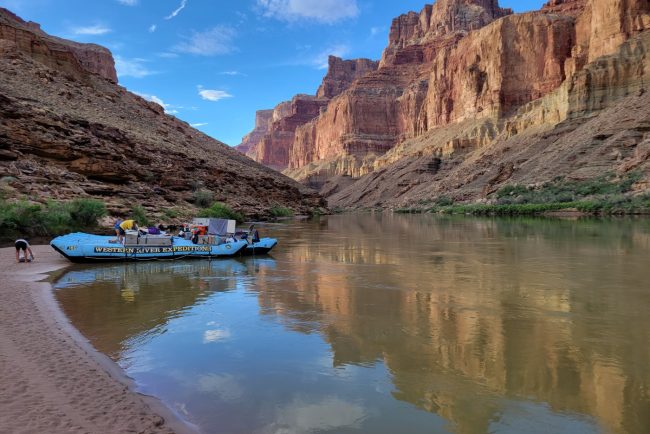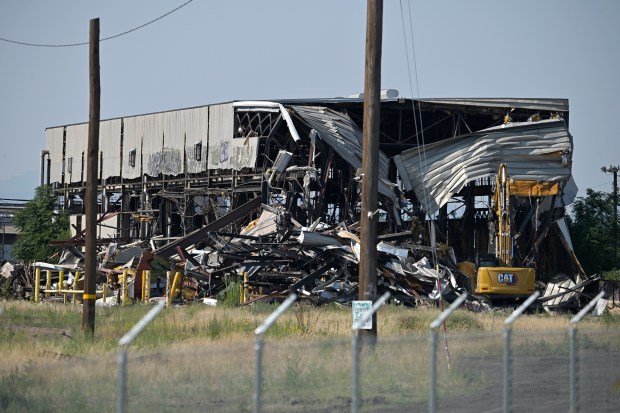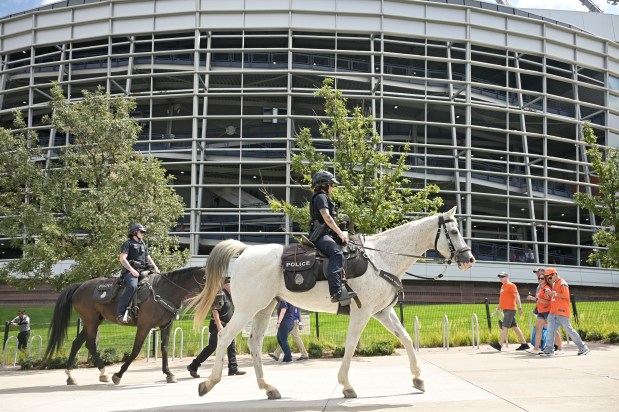
Colorado’s Lauren Boebert stands up for Epstein’s victims (Letters)
I am amazed that I now consider Rep. Lauren Boebert and Rep. Marjorie Taylor Greene to be heroes. — Daniel Badher, Denver
Letters
The pain of lost family and someone else’s Thanksgiving (Opinion)
My first Thanksgiving at my beau’s family table, I hid in the bathroom a half-dozen times to check my watch. Can we leave yet? Despite the lifelong ache to have my own regular family, with generations of happy family gatherings, and despite the steady, routine […]
Columnists
We need courage to change course on the Colorado River (Opinion)
The Colorado River is in crisis. The seven basin states just blew through a heavily anticipated deadline to announce a new deal on how they would divide up a dwindling resource. Meanwhile, Lake Mead and Lake Powell are teetering on the brink of collapse, and […]
Columnists


Kirk, a true believer in the First Amendment, wouldn’t want this (Letters)
Kirk was a true believer in the First Amendment I abhor the assassination of Charlie Kirk, CEO of Turning Point USA. I believe him to have been a righteous and moral voice for original American, constitutional, and Christian values upon which our great country was […]
LettersKirk was a true believer in the First Amendment
I abhor the assassination of Charlie Kirk, CEO of Turning Point USA. I believe him to have been a righteous and moral voice for original American, constitutional, and Christian values upon which our great country was founded, and along with millions of patriotic Americans, who love this country as he did, I grieve for his loss. He was a true believer in the First Amendment.
It is this inconsistency that I address today. The termination of employees in the public and private sectors for reacting contrary to the majority opinion on the assassination of Kirk is radically opposed to the very freedom that he espoused. Civil discourse is the foundation of our republic and contrary opinions and freedom of expression are two of the pillars on which our nation was founded. As abhorrent as I find opinions on social media that I strongly disagree with, I will defend the right of the publisher to express them.
The bigger issue that we face in this “instant media” world is the total lack of critical thinking skills. People feel free to throw out the first, poorly-thought-out, vacuous reaction to any news story — whether based in fact or fiction, and regardless of negative consequences. Social media has promoted this, by rewarding the first reactors to these news stories with “likes,” and re-publishing these reactions across the internet.
We are in a toxic environment where people are adverse to express their thoughts face-to-face, but have no restraint about publishing damaging and destructive discourse online because there is no reasoned debate to their published opinion.
Scott L. Stockton, Castle Rock
Up until this point, I agreed that the majority of cancel culture came from the far left. With the aftermath of the senseless assassination of Kirk, the calls for silencing those who call out his vile and divisive policy positions (including firing people), we are seeing cancel culture and First Amendment freedom of speech violations by the far right on steroids. If someone uses their employer’s platform to say something vile about Kirk, ok free to fire people. Pointing out controversial positions Kirk advocated does not seem to me to justify firing.
But if it’s an individual’s social media account is otherwise not connected to their employer, that’s cancel culture on the right and it is happening. Charlie would not want that or calls for retribution-driven political violence. RIP.
John W Thomas, Fort Collins
This has got to stop. All the outrage and blame directed at Democrats over the killing of Charlie Kirk by the president, vice president and his followers has got to stop.
Where was the outrage when Minnesota’s Speaker of the House, Melissa Hortman was murdered in her home along with her husband and the family dog? That assassin went on to seriously wound a colleague of Hortman and her husband and had a hit list of forty-four Democrats.
What did Trump do? Nothing. He didn’t order the flags at half staff for them, nor did he attend the funerals or even send a delegation. He couldn’t even be bothered to call Minnesota’s governor. Democrats didn’t rant and rave then and call for retribution from the GOP. Where’s the outrage for those murdered Americans? This has got to stop.
Nancy Rife, Wheat Ridge
It wasn’t our gun and it wasn’t our kid
Gun violence in schools is a horrible thing. But all those kids who walked out of school to protest the latest shooting need to look in the mirror to see what most of the perpetrators of this violence look like. They are young, and in most cases, students, or former students of these schools. Those of us who went to school back in the 1950s, 60s, 70s and 80s didn’t have this kind of problem, even though guns were readily available back then and gun laws were much more lax than the gun laws of today.
What’s the solution to today’s school shootings? How about going after the parents of these killers first as a start. Start charging the parents as accessories to these crimes, if their child gets hold of the parent’s gun, or guns, and commits one of these horrible crimes. If it’s not the parent’s gun and the perpetrator got the gun elsewhere, charge the person, or persons who enabled the child to get the gun.
Maybe people will get the message to properly secure whatever guns they might have so their kids can’t get to them. And, parents, quit blaming the rest of us for what your children do. You raised them, we didn’t. And to all you students wanting to blame everyone else with your little marches, it wasn’t our gun, it wasn’t our kid.
JB Adams, Arvada
Save the next generation from violence
A few years ago, I was coming out of my local recreation center and heard a little girl comment, while holding her father’s hand, “Look Daddy, No one died today!”, as she gazed up at our flag. It was not at half-staff.
How did we get to this state of affairs? My heart breaks while we posit rhetorical answers. We can do better and must ask our leaders on both polarities to come together.
Fifty years ago, an effort was begun to bring children from Northern Ireland to America to help them escape a sectarian war called, The Troubles. Catholic and Protestant, right and left today, were shown a different way to avoid hatred and violence. It helped pave the way for the negotiation of the Good Friday Agreement and peace. Twenty-three thousand young people have come to America and returned home changed for the better.
Much remains to heal and bind up ancient wounds, but this program has been a major influence in doing that. I stand willing to contribute to building bridges across our national divides so other nations don’t feel compelled to help our children escape from similar fates.
Anthony Massey, Broomfield
Editor’s note: Massey is the Colorado coordinator of Project Children.
Looking for a reading reset? Start local
Re: “Falling in love again with reading, and my stressed-out life,” Sept. 14 features story
I enjoyed Allyson Reedy’s essay on how she benefited from her own personal reading retreat. This is such a wonderful way to reset one’s internal compass. Rather than an A-Frame at Winter Park, I’ve done it many times at one of our many beautiful state parks, sitting by a campfire under the moon.
Should you decide to undertake your own private book camp, I hope you’ll consider packing a title or two from local creatives. The Colorado Authors League is our state’s best kept non-profit literary secret. We’ve been around since 1931 and represent over 300 Colorado authors and illustrators from many different genres. Learn more about us at coloradoauthors.org
Jack Maher, Parker
Editor’s note: Maher is president of the Colorado Authors League.
Preserve Burnham Yard’s archeological history, too
Re: “What stands between Broncos and a Burnham Yard stadium?” Sept. 14 news story
Those of us who do historic preservation work strive to find a balance between the needs for development and the preservation of our collective historic fabric. Personally, I think the redevelopment of the Burnham Yard and surrounding area into a new stadium neighborhood is a good reuse of this site.
While this article presents a good summary of the community involvement process, city and state permitting and taxing issues, and environmental cleanup challenges, and recognizes this was an active rail yard since the 1870s, it fails to mention anything concerning historic preservation.
As I understand from recent reports, there are a few significant historic buildings still standing at the site. There is also a high likelihood of historic archaeological remains at the Burnham site and the surrounding properties. As the article points out, there are not many historic records from that era making these archaeological resources vital sources of information for enhancing our understanding of the early days of the rail yard and surrounding neighborhood and the contributions they made to the city and state. I hope these resources are given proper consideration as the process goes forward.
Robert Mutaw, Louisville
Democrats need to do more to oppose Trump, not less
Re: “Colo. voters are dissatisfied with Democrats. Polis, Hickenlooper and Bennet can’t hide,” Sept. 14 editorial
The Post editorial on voter dissatisfaction with Democrats has it exactly wrong. Americans aren’t recoiling from the Democratic Party because office holders are focusing too much on Trump, but because too many are publicly silent in the face of Trump’s cruelty and corruption. Their failure to challenge the current sitting president, who is obviously showing cognitive decline while in office, is a large reason voters are upset.
Bravely opposing Trump’s rush to totalitarian dictatorship doesn’t mean Democrats aren’t keenly aware that Americans are struggling, nor that making the quality of life better for all Americans is not a top Democratic priority. But minimizing or normalizing Trump’s betrayal of his presidential oath, the Constitution, and of the American people will lead only to the destruction of what President Reagan described as a “country that would be a light unto nations, and a shining city upon a hill”.
Stephen Levin, Denver
Eliminate the income cap for Social Security
Re: “Social Security: Americans’ top asset isn’t a home or stocks,” Sept. 14 business story
The article deals with the future insolvency of Social Security, predicting it could happen as soon as 2033. I have read several articles dealing with this issue. They deal with different scenarios, such as, raising the interest that is currently charged, or reducing the amount recipients receive, etc.
One possible solution, that never seems to be brought up, is the income cap. Currently, everyone pays into the fund up to an annual income of $176,100, so anyone making that amount or less, pays based on 100% of their income. Anyone making over that amount pays no additional tax.
If the maximum payout were kept the same, and everyone payed into the fund based on 100% of their income, the fund would most likely remain solvent. The assumption here is that people making over $176,000 per year can just as easily afford to pay their fair share.
Steve Nash, Centennial
Sign up for Sound Off to get a weekly roundup of our columns, editorials and more.
To send a letter to the editor about this article, submit online or check out our guidelines for how to submit by email or mail.

Rosh Hashanah is reminder of our responsibility to each other (Opinion)
Jews across the world are preparing to celebrate Rosh Hashanah, the Jewish New Year. As the holiday that marks and celebrates the creation of the world, it is a time to reflect on the current state of the world. This year, that reflection feels especially […]
ColumnistsJews across the world are preparing to celebrate Rosh Hashanah, the Jewish New Year. As the holiday that marks and celebrates the creation of the world, it is a time to reflect on the current state of the world. This year, that reflection feels especially heavy.
Our community is still reeling from the recent school shooting in Evergreen and the assassination of Charlie Kirk. The shock and grief are heavy. These tragedies remind us of how vulnerable we are–and how quickly violence can shatter the lives of families and communities.
An ancient passage in the Talmud (Bava Batra 25a) offers a haunting metaphor for this vulnerability: “The world is similar to a building, enclosed on three sides, and the northern side of the world is not enclosed.” The sages imagined the world itself as a structure left open to the north, a reminder that there are always cracks through which danger, chaos, and suffering can enter.
This image echoes a verse from the prophet Jeremiah: “From the north shall disaster break loose upon all the inhabitants of the land” (Jeremiah 1:14). The Bible acknowledges what we feel so acutely in moments like this: there is no perfect safety. For reasons we may never fully understand, the world carries within it openings where pain can break through.
But Jewish tradition also provides a way for us to begin fortifying that opening and protecting ourselves from vulnerability. One teaching centers on the ancient ritual of Bikkurim, the offering of the first fruits. Farmers would bring the first produce of their fields to the Temple in Jerusalem as an act of gratitude. But according to tradition, this ritual could not begin until every single family in the nation had received its portion of land. In other words, no one was permitted to celebrate until everyone was able to participate. Joy was incomplete if even one family was left out.
This is a powerful teaching about interconnectedness. It reminds us that our well-being is bound up with the well-being of others, and that true celebration, true safety, and true healing can only exist when everyone shares those benefits.
That message speaks powerfully in light of recent events. On one level, the pain and shock we felt reminds us that we are connected–what happens in someone else’s backyard does affect me. On the other hand, these tragedies also reveal the fractures in our society, the lack of interconnectedness, where all that seems to matter is my satisfaction, my opinion, and my way of life.
If we are to heal as a community and as a country, we must reclaim that sense of interconnectedness and responsibility for one another. We must refuse to let our shared home remain open to chaos and despair. We can begin to close that open side–one person at a time, one congregation at a time, one community at a time.
Through our deeds of kindness, justice, and connection, we help close the openings through which pain seeps into the world–and in doing so, we bring blessing not only to ourselves, but to all who share this fragile, beautiful home.
As we enter Rosh Hashanah, may this New Year be a year of healing, safety, and renewed connection–for our community, our country, and our world.
Barry Gelman is Rabbi of The Denver Kehillah and a member of the executive committee of the Rocky Mountain Rabbis and Cantors (RMRC)
Sign up for Sound Off to get a weekly roundup of our columns, editorials and more.
To send a letter to the editor about this article, submit online or check out our guidelines for how to submit by email or mail.

Colorado learned long ago that no school is safe from gun violence — a lesson Jeffco should have heeded (Editorial)
The tragedy at Evergreen High School reminds us that even this country’s most idyllic communities — from our mountain towns to the quaint cities on the plains — must prepare for violence in their schools. School shootings have never been only an inner-city problem, and […]
ColumnistsThe tragedy at Evergreen High School reminds us that even this country’s most idyllic communities — from our mountain towns to the quaint cities on the plains — must prepare for violence in their schools. School shootings have never been only an inner-city problem, and to believe otherwise is to ignore Colorado’s tragic history.
We were dismayed to learn that security at Evergreen High School may not have been a priority because of the school’s location about an hour west of Denver in the forested foothills of Jefferson County.
Mental illness and radicalization can occur anywhere, especially in a society connected seamlessly online to every type of content imaginable.
Every school in this state needs a dedicated resource officer who can respond immediately to a threat on campus.
Seconds matter in a shooting, and two students from Evergreen High School are in the hospital fighting for their lives. Jefferson County Sheriff’s Deputies responded quickly to the shooting but even that was unable to prevent tragedy.
The evening before the shooting at Evergreen High School, the school’s principal told concerned parents that a school resource officer had been “deprioritized” for Jefferson County’s mountain schools. The school’s full-time deputy was on medical leave, and the contract with the Jefferson County Sheriff’s Office has a deputy on campus “as staffing allows.” At the time of the shooting, the officer assigned to the campus was responding to a call off campus.
Every Colorado school needs an armed officer on campus during school hours. We are glad the Jefferson County School District will increase security before students return, and a similar plan should be put in place at every school in the state.
School violence has struck a charter school in the suburban community of Highlands Ranch where a road is now named for the hero — Kendrick Castillo — who saved his classmates but died. A few miles north at Arapahoe County High School in Littleton, Claire Davis was shot and killed by one of her classmates. Two teachers were shot and injured in the middle of Denver at East High School, and another student was shot and killed in the school’s parking lot a few weeks earlier.
But small towns, rural communities and the mountains are not immune. In 2006, a gunman took students hostage at Platte Canyon High School in Bailey, about a half-hour drive from Evergreen on twisting mountain roads. Emily Keyes was shot and killed.
We understand having law enforcement in every school in this state is a challenge financially and logistically, but in the face of yet another school shooting, we don’t see another option.
Americans can no longer be complacent. Our schools are not safe, and while locking down Evergreen quickly undoubtedly saved lives, we know that having a trained police officer on campus reduces the response time to seconds.
The teenager who shot two classmates and then killed himself last week had been active online in what experts describe as a new nihilism — the belief that life is meaningless — combined with a twisted desire to destroy society.
The teen’s social media accounts contained antisemitic and white supremacist posts and glorified other school shooters. According to the Jefferson County Sheriff’s Office, the teen had been “radicalized through an extremist network.”
The only response is to harden our schools and protect as many students as possible. Of course, statistically, it is still unlikely that a student will be harmed in an act of violence on campus. The riskiest part of a student’s day is still apt to be their drive home.
But just as we require our children to ride in car seats, wear seatbelts and often buy them their first cars with airbags and other safety features, so too must we make schools as safe as possible.
We pray the victims of this shooting — 18-year-old Matthew Silverstone, and a second student who has not been identified at the behest of his family — survive and thrive.
And we pray that the next time someone targets our schools with violence that they are met by a show of force from law enforcement that protects innocent life.
No place is immune from school violence, a lesson we thought Colorado learned long ago when 12 students and a teacher were killed at Columbine High School.
Sign up for Sound Off to get a weekly roundup of our columns, editorials and more.
To send a letter to the editor about this article, submit online or check out our guidelines for how to submit by email or mail.

Developer’s fees don’t dictate home prices — they cut into profits (Letters)
Developer’s fees cut into profits; don’t dictate prices Re: “Fees add $68K to home’s cost, study finds,” Sept. 15 news story This is regarding Monday’s very detailed and informative article on fees charged by cities on new housing development. There is almost no relationship between […]
LettersDeveloper’s fees cut into profits; don’t dictate prices
Re: “Fees add $68K to home’s cost, study finds,” Sept. 15 news story
This is regarding Monday’s very detailed and informative article on fees charged by cities on new housing development.
There is almost no relationship between fees paid by housing developers and the prices they charge. Simply put, developers charge what the market will bear. So higher fees just reduce their profits. That’s why developers are always pushing for lower fees — they will make more money, plain and simple.
Cities should charge new development for the full costs of preventing increased impacts to existing residents. That includes tap fees adequate to maintain an adequate long term water supply in the face of global warming and the resulting inevitable cuts in supply, especially trans-mountain diversions from the Colorado River, in the face of new developments’ increased demands.
It also includes charging development impact fees adequate to pay for the investments needed to prevent increased traffic congestion and worsening air pollution, and maintaining per capital levels of service for parks, rec centers, libraries, schools, permanently affordable housing units, etc.
Making “growth pay its own way” converts developers’ excess profits into investments that maintain quality of life for existing residents. That should be the job of government, not increasing developers’ returns at the expense of people already here.
Steve Pomerance, Boulder
Proud patriot says “authoritarianism stinks”
Re: “Trump threatens Chicago with force; Pritzker calls him ‘wannabe dictator’,” Sept. 7 news story
“I love the smell of deportations in the morning” — President Donald Trump posted on his social media Sept. 6.
I am a Vietnam veteran; Distinguished Flying Cross, Purple Heart, air medals, and a veteran of dozens of napalm missions; witnessing the powerfully indiscriminate damage resulting from these missions. I love the smell of democracy 24 hours a day. The smell of authoritarianism stinks.
David L Stevenson, Denver
Even Chat GPT knows mass deportations will hurt Americans
I asked Chat GPT on Monday what the “long term economic and social impact of deporting law-abiding undocumented immigrants” would be on America. I wanted to share the response, which is sourced from the American Immigration Council, Penn Wharton Budget Model, ITEP ( Tax Contributions of Undocumented Immigrants,2022), the Brookings Institute (Labor Market Research) and Arizona State University Research on Family and Child Impacts.
“Findings consistently show significant negative economic, fiscal,and social consequences.
1. Economic Growth: Estimates suggest mass deportations would shrink GDP by 4 -7 percent or 1.1 to 1.7 trillion dollars annually.
2. Labor Markets: Immediate labor shortages in agriculture, construction, hospitality, food processing and care sectors.
3. Fiscal Costs: Undocumented Immigrants contribute $96.7 billion in Taxes (2022). Deportations reduce revenue while enforcement costs rise sharply.
4. Social Insurance: Loss of payroll tax contributors would worsen long-run Social Security and Medicare solvency.
5. Family and Children: Deportations separate families, increase child poverty and reduce long term human capital and earnings.
6. Community Impact: Local economies suffer from reduced consumer demand, lower property values and weakened civil participation.
7. Administrative Costs: Enforcement, detention,and transportation expenses are very high; diplomatic and humanitarian challenges follow.
8. Demographics: Reduced labor force growth and accelerated aging, undermining long-term US economic dynamism.
Summary: Deporting law-abiding undocumented immigrants is not a low-cost policy option. It would reduce GDP, increase consumer prices, shrink tax base, weaken social insurance, destabilize families and communities, and impose heavy enforcement costs. Evidence indicates that large scale removals would create broad ,lasting harm to the U.S. economy and society.”
Brent Lambi, Central City
Kilmeade’s remarks are unacceptable
Re: “Kilmeade apologizes for saying mentally ill homeless people should be executed,” Sept. 15 news story
Reading that Fox News host Brian Kilmeade, while talking about the stabbing death of Iryna Zarutska, said on air that mentally ill homeless Americans should be killed by lethal injection brought back chilling memories of the Nazi’s T-4 euthanasia program that killed thousands of handicapped and “mentally defective” persons in the 1930s and 1940s. Kilmeade should be fired despite the fact that he apologized.
Flint Whitlock, Denver
Attack on Qatar jeopardizes U.S. diplomacy
Re: “Qatar denounces Israel before major summit for attack in Doha,” Sept. 15 news story
The Israeli attack on Qatar has made me wonder about U.S. policy in the Middle East. Both are military and political allies of this country, and the U.S. has encouraged Qatar in its mediation attempt to bring a ceasefire in Gaza. President Trump has made peacemaking in Gaza a priority of his administration, and had just sent a new proposal for Hamas to consider the day before the Israeli attack. In fact, the Israelis assumed the Hamas leaders would be assembling at that time to consider the American proposal. Israel did not warn the U.S. ahead of time, but only told them after they had already launched the attack. The White House criticized the action; in response, Netanyahu said that he would attack Hamas wherever and whenever he could.
Israel, a small nation dependent on our country for military support, is thumbing its nose at us, the most powerful country in the world. Their attack on Qatar has not only damaged us in the minds of Arab leaders and their people throughout the Middle East, but has undermined the credibility of our foreign policy in general.
Marshall S. Clough, Greeley
Sign up for Sound Off to get a weekly roundup of our columns, editorials and more.
To send a letter to the editor about this article, submit online or check out our guidelines for how to submit by email or mail.

Colorado voters are dissatisfied with Democrats. Polis, Hickenlooper and Bennet can’t hide (Editorial)
Americans are recoiling from the Democratic Party, and even in blue states like Colorado, Democrats are feeling the burn. With Republicans fielding the best candidate for governor they’ve had in a decade – Sen. Barbara Kirkmeyer – liberal politicians would be wise to address the […]
OpinionAmericans are recoiling from the Democratic Party, and even in blue states like Colorado, Democrats are feeling the burn.
With Republicans fielding the best candidate for governor they’ve had in a decade – Sen. Barbara Kirkmeyer – liberal politicians would be wise to address the root causes of this dissatisfaction publicly, frequently and head-on. The reality is that Americans are struggling — our politics are becoming more violent, everything is more expensive, and the job market is tightening.
After years of enjoying popularity, Colorado’s top Democrats are now showing a remarkable drop in their approval ratings among voters. President Donald Trump remains deeply unpopular in the state, but Gov. Jared Polis, Sen. Michael Bennet and Sen. John Hickenlooper are failing to break a 50% approval rating, meaning more of those asked than not said they were unhappy with the politicians’ work.
Unaffiliated voters claim outright majority of Colorado electorate
/*! This file is auto-generated */!function(d,l){“use strict”;l.querySelector&&d.addEventListener&&”undefined”!=typeof URL&&(d.wp=d.wp||{},d.wp.receiveEmbedMessage||(d.wp.receiveEmbedMessage=function(e){var t=e.data;if((t||t.secret||t.message||t.value)&&!/[^a-zA-Z0-9]/.test(t.secret)){for(var s,r,n,a=l.querySelectorAll(‘iframe[data-secret=”‘+t.secret+'”]’),o=l.querySelectorAll(‘blockquote[data-secret=”‘+t.secret+'”]’),c=new RegExp(“^https?:$”,”i”),i=0;i<o.length;i++)o[i].style.display="none";for(i=0;i<a.length;i++)s=a[i],e.source===s.contentWindow&&(s.removeAttribute("style"),"height"===t.message?(1e3<(r=parseInt(t.value,10))?r=1e3:~~r<200&&(r=200),s.height=r):"link"===t.message&&(r=new URL(s.getAttribute("src")),n=new URL(t.value),c.test(n.protocol))&&n.host===r.host&&l.activeElement===s&&(d.top.location.href=t.value))}},d.addEventListener("message",d.wp.receiveEmbedMessage,!1),l.addEventListener("DOMContentLoaded",function(){for(var e,t,s=l.querySelectorAll("iframe.wp-embedded-content"),r=0;r<s.length;r++)(t=(e=s[r]).getAttribute("data-secret"))||(t=Math.random().toString(36).substring(2,12),e.src+="#?secret="+t,e.setAttribute("data-secret",t)),e.contentWindow.postMessage({message:"ready",secret:t},"*")},!1)))}(window,document);
These results from a poll conducted in early August of 1,136 registered Colorado voters by Magellan Strategies mirror what we are seeing across the nation. Americans are dissatisfied.
According to a New York Times analysis of available voter registration numbers, the Democratic Party is hemorrhaging voters across the board and particularly in swing states. Meanwhile, the Republican Party is gaining voters after years of losses.
Part of the shift is voters simply changing their affiliation to unaffiliated, but the Magellan Poll clearly indicates that there is more afoot than voters just looking to participate in open primaries.
Magellan, a conservative-leaning Colorado firm, found that among voters who supported Kamala Harris in 2024, 47% have unfavorable opinions of the Democratic Party.
To be clear, voters who were polled still said they were more likely to support a Democrat for governor next year. Only 38% of those polled said they would likely support a Republican for governor. Kirkmeyer has an uphill battle to be certain, but her opponents are weakened.
We’d hazard a guess that the non-existent Democratic primary in 2023 to challenge a sitting president who was showing cognitive decline while in office is part of the reason voters are upset. It will take time for voters to forgive – and no one will ever forget – the disastrous presidential debate.
But national politics can’t take all the blame.
Gov. Jared Polis has served almost eight years in office and 52% of voters told pollsters that they had an unfavorable opinion of his work, and 35% strongly disapprove. That is softened only by the fact that 56% of voters polled strongly disapproved of the job President Donald Trump is doing, but Colorado has rejected Trump three times in general elections and the Republican Party rejected him in the 2016 caucus.
U.S. Sen. Michael Bennet is doing slightly better with 44% of voters reporting disapproval of him, and U.S. Sen. John Hickenlooper was at 49%.
Bennet is going to face Attorney General Phil Weiser in the Democratic Primary for governor. Weiser wasn’t included in the poll and neither were any of the Republican candidates.
The bottom line is that Democrats cannot spend this election talking about Donald Trump, and pretending that voters don’t have real concerns about the governance of both political parties. Voters may still put many or even most Democrats into office, but if the party wants to recover, its top leaders must start this election cycle with something more than fear and loathing.
Coloradans are concerned. The Magellan poll found that 54% of voters anticipate the economy will decline in the next 12 months (with more Democrats expressing this fear than Republicans), a pessimistic view that requires our politicians to articulate a plan for the worst-case scenario.
Similarly, 54% think Colorado is headed in the wrong direction (with more Republicans unhappy than Democrats), and the high cost of living, public safety, and homelessness were mentioned frequently by voters as top concerns, according to Magellan. These issues will only be harder to address given the decline in federal, state and local revenue sources. Our next governor will articulate a feasible plan.
Finally, Democrats will win safe seats in 2026 with their heads in the sand, but if the party wants to gain ground in swing districts, its politicians are going to have to step up to the challenge at hand – restoring faith in and favorability of the party. Can that be done without rehashing the many missteps of the past four years? We would like to see elected officials be accountable and transparent.
But Colorado must move forward, as must the nation.
If Democrats want to stop losing ground, they’ve got to appeal to voters as far more than an alternative to Trump.
Sign up for Sound Off to get a weekly roundup of our columns, editorials and more.
To send a letter to the editor about this article, submit online or check out our guidelines for how to submit by email or mail.

Pettersen: The Evergreen High School shooting feels overwhelming, but gun violence is a policy choice
I was sitting in my congressional office before heading to the House floor for votes when my phone lit up. Charlie Kirk – right-wing activist and podcaster – has been shot in the neck at a rally on a college campus in Utah. The growing […]
ColumnistsI was sitting in my congressional office before heading to the House floor for votes when my phone lit up. Charlie Kirk – right-wing activist and podcaster – has been shot in the neck at a rally on a college campus in Utah. The growing political violence we’ve seen recently has been gut-wrenching and terrifying. I’m not only scared for the safety of friends and colleagues but fearful for the future of our country.
Then my phone lit up again. I received additional horrifying news: there was, at that very moment, an active shooter at Evergreen High School.
I was stunned sitting on the couch thinking about the parents receiving word that there was an active shooter and that they were warned not to go to the school for their safety. The helplessness and not knowing if they’d ever see their kids again. My heart breaks for the students who continue to fight for their lives in the hospital, the parents who are at their bedsides not knowing if they will ever come home, and for the kids and educators who will carry the trauma of this day forever.
Just like every parent reading the headline, I felt the shock and terror and thought: what if that was my kid? What if that was his school? I’m outraged that this is the result of failed policy and inaction.
/*! This file is auto-generated */!function(d,l){“use strict”;l.querySelector&&d.addEventListener&&”undefined”!=typeof URL&&(d.wp=d.wp||{},d.wp.receiveEmbedMessage||(d.wp.receiveEmbedMessage=function(e){var t=e.data;if((t||t.secret||t.message||t.value)&&!/[^a-zA-Z0-9]/.test(t.secret)){for(var s,r,n,a=l.querySelectorAll(‘iframe[data-secret=”‘+t.secret+'”]’),o=l.querySelectorAll(‘blockquote[data-secret=”‘+t.secret+'”]’),c=new RegExp(“^https?:$”,”i”),i=0;i<o.length;i++)o[i].style.display="none";for(i=0;i<a.length;i++)s=a[i],e.source===s.contentWindow&&(s.removeAttribute("style"),"height"===t.message?(1e3<(r=parseInt(t.value,10))?r=1e3:~~r<200&&(r=200),s.height=r):"link"===t.message&&(r=new URL(s.getAttribute("src")),n=new URL(t.value),c.test(n.protocol))&&n.host===r.host&&l.activeElement===s&&(d.top.location.href=t.value))}},d.addEventListener("message",d.wp.receiveEmbedMessage,!1),l.addEventListener("DOMContentLoaded",function(){for(var e,t,s=l.querySelectorAll("iframe.wp-embedded-content"),r=0;r<s.length;r++)(t=(e=s[r]).getAttribute("data-secret"))||(t=Math.random().toString(36).substring(2,12),e.src+="#?secret="+t,e.setAttribute("data-secret",t)),e.contentWindow.postMessage({message:"ready",secret:t},"*")},!1)))}(window,document);
I grew up here. I attended high school in Jefferson County, not too far from Columbine. I still remember the shock I felt as a junior in high school when the unimaginable happened. Back then, it shocked the nation. But now it’s become all too common. Mass shootings have become an ugly stain on our state. My heart breaks that Evergreen now joins the long line of Colorado communities forever changed by a mass shooting.
While Colorado has a history of making national headlines for gun violence, we’re certainly not unique. Gun violence is the leading cause of death for children in this country. Not cars. Not cancer. But gun violence. It’s worth repeating – guns are the number one killer of our kids. And the most outrageous part about all of this is that it’s completely preventable. How many lives do we need to lose before we are willing to say enough?
Just weeks ago, we saw kids in Minnesota killed at school. And earlier this summer, lawmakers murdered outside their homes. Now a conservative activist. Now once again, high school students in Evergreen. Who’s going to be next? It feels like we’ve reached a breaking point. This is untenable.
We are living through a dark moment in our country’s history – one that will be remembered for whether we confronted the radicalization and violence tearing at our communities or allowed it to break us apart. As a society, we are being forced to answer a fundamental question: is this who we want to be as a country? This is a policy choice. Not a political one.
We have to ask ourselves – do we want to live in a country where our kids are being gunned down in their classrooms? Where your life hangs in the balance at a grocery store, a movie theater, or a political rally?
This is the moment to decide. Overwhelmingly, we want a world where our kids can come home safe from school. Where their lives aren’t at risk because of what they believe. But we need leaders who have the courage to stand up and decide that we are no longer going to standby while one more life is taken too soon.
We’re all still reeling from the events of this week. But our community is resilient. The world feels heavy right now but we can’t give up hope. My kids and our kids depend on it.
If you are struggling and need support, please call 988 to be connected to someone who cares. Also know that my team and I are here to support you and our community every step of the way as we recover from this tragedy.
Together, we can build the future our children deserve.
U.S. Rep. Brittany Pettersen was first elected to represent the 7th Congressional District in Colorado in 2022.
Sign up for Sound Off to get a weekly roundup of our columns, editorials and more.
To send a letter to the editor about this article, submit online or check out our guidelines for how to submit by email or mail.

I once found a sealed urn in the Grand Canyon, and other examples of failing to ‘pack it out’ (Opinion)
Part of my job as a Grand Canyon educator is picking up stuff a hiker drops or leaves behind next to a trail. Some of the things I’ve found this summer lead me to wonder what the John Muir they were thinking. A fast-food burger, […]
ColumnistsPart of my job as a Grand Canyon educator is picking up stuff a hiker drops or leaves behind next to a trail. Some of the things I’ve found this summer lead me to wonder what the John Muir they were thinking.
A fast-food burger, in the original wrapper. I suppose they left it for the timid woodland creatures, except if fast food isn’t good for us, why would critters want it?
Someone’s last remains. When a hiker pointed out a shiny object off the trail, I clambered over rocks to find a sealed urn of cremains, which is illegal to leave in a national park. Local tribes have also asked that visitors avoid doing this for religious considerations.
I reported finding the urn to park rangers, and for the next month was identified as “the lady who found the body.”
A can of corned beef. We found this on day three of a seven-day backpack. Those who abandoned it surely thought, “Oh, whoever finds this shall fall upon it with glee!” Except we had enough food, thanks. Rather than carry a three-pound can of beef, though, we ate it, and yes, it was vile.
Balloons. I risked life and limb one day clambering down a scree slope after what I thought was an abandoned backpack only to find deflated balloons. It is a lovely thought to release balloons to honor a friend. But creatures can get tangled in the strings or eat them to serious ill effect.
Mascara wand. I understand that many women cannot bear to be without their makeup, but on the trail? For one thing, you are all sweaty and dirty, or at least, I am. In the same vein, I have come across discarded bottles of cologne. Perhaps the owners finally realized that no perfume can cover up the smell of a long hike.
Glow sticks. Tied to the trees. Not only are they plastic, they’re toxic to any animal who chews on them.
Double boiler filled with rice. It might make sense to find this in a campsite, but four miles up the trail?
Underwear. I do know about these situations. Someone has an unavoidable emergency and no TP so they use whatever is at, um, hand.
Plastic tooth floss picks. Oral hygiene is important. However, most people do not leave their toothbrush behind, so why leave the silly things that only weigh one-tenth of an ounce?
A five-pack of beer. I assume they drank one and left the rest for later, then did not find tepid beer palatable. But stashing items along the trail is problematic. We never know if you are really going to pick it up later, or if you just got tired of hauling it around. So best keep it with you.
Laminated photographs. These are often left as a memorial. Does your loved one really want you to honor them by littering public lands with their portrait?
One shoe. How does one hike out with one shoe? Although I did once meet a hiker wearing a single shoe and sock, one for each foot. Another time, we found a jacket, then a shirt, then a pair of pants, then socks. I guess they kept the shoes.
A hemostat used to compress a blood vessel. Was someone prepping for emergency surgery?
An empty backpack. How did they get their gear out?
A full backpack, including, among other things, a queen-sized bed sheet, a beach towel, canned food, and two hardback books. Rumor has it that the hapless hiker yelled, “I can’t do this!”, grabbed a bottle of Gatorade, and threw the pack off the trail. At this point, the hiker was five miles from the trailhead.
The first rule of “leave no trace” is to plan ahead. Perhaps one should sit down with one’s supplies and ask: Do I really want to lug these books, this frying pan, that good bottle of wine?
If yes, more power to you, and keep on lugging! Just make sure you take it all back out with you.
Marjorie ‘Slim’ Woodruff is a contributor to Writers on The Range, writersontherange.org, an independent nonprofit dedicated to spurring lively conversation about the West. She is a Grand Canyon educator.
Sign up for Sound Off to get a weekly roundup of our columns, editorials and more.
To send a letter to the editor about this article, submit online or check out our guidelines for how to submit by email or mail.

Scott Gilmore’s layoff is another broken promise for the indiginous community (Opinion)
Over the past couple of days, I’ve had conversations and reviewed numerous letters from individuals within the City and County of Denver, all of whom are committed to ensuring the continuation of Scott Gilmore’s work. My great-great-uncle once said: “They made us many promises, more […]
ColumnistsOver the past couple of days, I’ve had conversations and reviewed numerous letters from individuals within the City and County of Denver, all of whom are committed to ensuring the continuation of Scott Gilmore’s work.
My great-great-uncle once said:
“They made us many promises, more than I can remember, but they never kept but one: They promised to take our land, and they took it.” — Chief Red Cloud (Oglala Lakota, known as Mahpíya Lúta).
There is a significant divide between what is being promised and the reality of keeping that promise. We know that you cannot replace Scott Gilmore in the City of Denver, no matter how hard you try. Stop fooling yourself and listen. We know what is best for us. Listen to us.
The individuals who made the decision to include Scott Gilmore, who worked for years in the city’s Parks Department, in last week’s layoffs never consulted with our community. These “officials” never do. We are the forgotten people, the invisible people who are thrown away because of money. Who in the Denver City administration was ever adopted in a Sacred Hunka ceremony?
The action is going to hurt 100,000 American Indians living on the Front Range directly.
Who amongst the Denver administrators knows our creation story of the Buffalo? Who amongst you is going to the sweat lodge and pray with us as we make plans about Buffalo restoration? Who has ever been in a Pipe Ceremony? Who knows how to handle that pipe? What is its significance?
It is doubtful that any of your staff will get invited to a Yuwipi Ceremony. These are things that cannot be learned from a book; they can only be realized through participation. You can’t just expect to participate because you want to. You must be invited. It takes many years to develop the respect of our people. And even longer to develop the trust. It takes even longer to become a part of our Sacred Circle of Life.
We have a different way of seeing the world and everything around us. This is our homeland. This is where our ancestors died protecting a way of life. We have never forgotten our ways despite the torture and brutal actions to convert us to your ways.
We had our civil ways of interacting with other people. Among the Cheyenne, we had a sacred council of peace, called the Council of 44. The members were peace chiefs. We did not seek out war against people coming to our homelands. We sought peace until such a time that our destiny and continued existence were in jeopardy. Then and only then did we retaliate to protect our families and a way of life.
The people who came here ignored all those good ways and forced their concept of civilization on us. All my life, I have said that I hope that I never succumb to becoming civilized. Now more than ever, when I look across America and see what is happening on the national level, I see the devolution of your civility. That kind of future is bleak and uncomfortable at best. That is not what we want.
Who amongst you knows the leadership structure of the Denver Indian community? Who speaks for our Denver community? Do you know perhaps even one person? Do you have any connections with the leaders or community members in our area? Our community is small, and when someone like Scott comes along, we are comforted and start growing confidence that perhaps the city administration will look back at the iniquitous history that left us landless in our own homeland.
Our ways strongly condemn breaking promises. It emphasizes the importance of keeping one’s word, highlighting the negative consequences of dishonesty and the value of trustworthiness. We use “careful consideration” before making a promise and stress the need to fulfill it.
The city has put us in a difficult position because we know that you will never be able to fulfill your promises. It took Scott most of his entire career to gain the confidence and trust needed for us to trust and respect him. He earned it, and he knows the secrets needed to make and sustain good relationships with our diverse community.
My people think differently from you. We always have and always will. That is the innate nature of our people. Our values are vastly different than yours. The first law of our people is respect, something that is sorely lacking in the ways of the people around us.
The second way of our people is about relationships. We try to treat everyone as relatives. This is hard to do because it is a foreign concept for others. We end our prayers by saying mitaku oyasin …. all my relatives.
We tell our children to listen and only speak when spoken to. We have similar expectations in all our relationships. Listen! That is difficult for many people who make critical decisions for the people. We are a small community with no degrees of separation; we all know each other. We are asking you to bring Scott Gilmore back. It is a straightforward request to fulfill.
You have seen many letters from many of our people. And only a few responses promise things that we know can’t be kept.
We are watching and organizing our future action. Please don’t try that famous historic tactic of divide and conquer. It would only exacerbate this situation.
We want to negotiate with you and find a meaningful compromise that works for our people. We want you to listen, we want you to hear our concerns, because we are tired of looking back and seeing the genocide of the past. We want a rightful place in creating a meaningful future for our people in our homeland.
Richard B. Williams is a Lakota Elder who has lived in Denver for 54 years.
Sign up for Sound Off to get a weekly roundup of our columns, editorials and more.
To send a letter to the editor about this article, submit online or check out our guidelines for how to submit by email or mail.

Here’s why the Broncos’ plan to redevelop Burnham Yard is far more than just another new stadium district popping up in America (Editorial)
The Broncos are poised to stay in the heart of Denver, and that is an announcement that all of Colorado can celebrate, even if they’ve never cheered for the orange and blue. Greg Penner, CEO of the Broncos, announced Tuesday morning that the football team’s […]
OpinionThe Broncos are poised to stay in the heart of Denver, and that is an announcement that all of Colorado can celebrate, even if they’ve never cheered for the orange and blue.
Greg Penner, CEO of the Broncos, announced Tuesday morning that the football team’s ownership group plans to spend billions of dollars transforming an abandoned railyard just southeast of downtown into a new stadium and entertainment district.
In an exclusive interview with The Denver Post, Gov. Jared Polis, Mayor Mike Johnston and Greg Penner shared a vision for Burnham Yard that is far more than just another billion-dollar stadium project in a country that financially, and often emotionally, supports 32 teams in the National Football League.
“Sometimes you need constraints,” Penner said, explaining that his team was drawn to Burnham Yard by the possibility of using some of the existing buildings, rusted equipment, and even the old switchyard.
Those constraints include contaminated land, historic buildings, a working rail line, and acquiring splotches of land one at a time to reach about 100 acres that Penner and his group have quietly spent the last year acquiring in a city where less than a quarter acre of land sells for about a half-million dollars. We can see how the constraints on the site will lend themselves to an authentic project that feels less like a privately owned utopia and more like a natural extension of the city’s core.
If everything comes together the Broncos stadium at Burnham Yard will give Denver a state-of-the-art venue that can compete for tourism-generating events year-round, a transit-oriented development that offers visitors alternative means of fast, easy transportation, and a revitalized part of the city that is now a blighted brownfield.
Our biggest concern with this location was the need for Denver Water to move some of its operations, including brand new buildings, and sell the land to the Broncos as part of their 100-acre footprint. The CEO of Denver Water, Alan Salazar, assured us early on that he would not let the project increase water rates.
Fortunately, Penner and Johnston said the final agreement will make Denver Water whole. The new Denver Water headquarters building will remain where it is, but the Broncos will acquire new land for Denver Water’s operations equipment and repair facilities, and pay for the new buildings on the site.

“This was a good outcome,” Penner said. “But also Alan (Salazar) and his team were very tough, so it was not an easy one to get to resolution.”
We appreciate everyone’s diligence in getting to this point where Burnham Yard — despite and because of all the complications and constraints — is the preferred location for the new Broncos stadium.
Penner’s vision is that the new stadium and entertainment district will embrace the history of Burnham Yard, maintaining some of the existing buildings and even some of the historic equipment to make this project so much more than another mixed-use development. Too often, developments of this size that pop up on virgin ground get lost to boring cookie-cutter street scaping and architecture. But the Broncos’ owners aren’t building a Disneyland an hour south of Denver where the “Mainstreet” will look just like the one outside Orlando.
Polis and Johnston deserve credit for bringing 58 acres of state-owned land to the table. The project supports urban infill and it will capitalize on the existing light-rail station at the location and future plans for a Front Range Passenger Train that drops off commuters from north and south of the Denver Metro Area.
“This is a chance to showcase transit-oriented development in a very special place,” said Polis, who has used his influence during his two terms in office to champion our fledgling rail system and public transportation.
Denver Mayor Mike Johnston emphasized the win for Colorado that not only will the 58 acres of Burnham Yard be reborn after having sat vacant for 10 years, but also the 80 acres under the existing Empower Field and Mile High Stadium will revert to city ownership, creating a once-in-a-lifetime opportunity for the city to direct its own development, including providing affordable housing in a city where all but the most affluent buyers have been priced out.
All three men cautioned that there was a risk the project could not move forward as envisioned. Some parcels of land still must be acquired and obviously the Broncos’s owners need to finalize their design and architectural plans.
But we would rather celebrate too early than let the moment slip by.
The preferred alternative, should this plan be stymied by environmental remediation costs, neighborhood opposition, or bungled land sales, is in Lone Tree. That is about an hour south of the city center, but Lone Tree is a small town that will continue to thrive even without a multi-billion-dollar investment from the Broncos.
Finally, we would like to celebrate that the Broncos’ plans expose the public to much less risk than other projects. For example, Las Vegas financed almost half of the Raiders’ $2 billion stadium with a hotel room tax.
Both Polis and Johnston emphasized that the Broncos’ owners did not want a taxpayer-funded stadium and that the redevelopment project would not require a tax increase of any sort.
But we do urge some caution and restraint as this project rolls forward with an aggressive timeline that could have the Broncos playing their first game in the new stadium in 2031.

Polis and Johnston can be extremely transparent about the subsidies for this project. Are the Broncos going to pay fair market value for the state-owned land and the nearby parcel owned by Denver Water? Will the Broncos’ owners be granted taxing authority to levy higher property taxes and sales taxes on future homeowners and businesses in Burnham Yard? How many tax subsidies will the Broncos receive from the city and state?
Penner, Polis and Johnston said it is far too early to answer those questions, as there isn’t even a site plan for the development yet. Long before a special district or metropolitan district gets approved, the Broncos’ owners must begin the planning process for zoning approvals. Tax increment financing won’t be an option until the Department of Urban Renewal completes its assessment of the land. It has become a given, however, that every developer on the Front Range be given taxing authority by the city or county, and it is likely that this project will also qualify for tax breaks due to the nature of the remediation needed on the land.
Those concessions to the Walton-Penner Ownership Group could transform Burnham Yard into a vibrant community that fits seamlessly with the existing neighborhood, while freeing up 80 acres at the old Mile High site for a housing project directed by the City of Denver. The benefit will far outweigh the costs and the Broncos will remain right where they belong, only a few miles from the historic Mile High location and close to the beating heart of the city.
Sign up for Sound Off to get a weekly roundup of our columns, editorials and more.
To send a letter to the editor about this article, submit online or check out our guidelines for how to submit by email or mail.

Dark money groups have corrupted Denver School Board elections (Opinion)
Are the Denver School Board elections transparent and democratic? Not really. Sadly, the Denver School board campaigns are far less democratic than any other Denver elections with two “dark money” groups providing more than 70% of the funding. We are talking more than $1 million […]
ColumnistsAre the Denver School Board elections transparent and democratic?
Not really.
Sadly, the Denver School board campaigns are far less democratic than any other Denver elections with two “dark money” groups providing more than 70% of the funding. We are talking more than $1 million from these two groups in 2023, and expect the number to be even higher this fall.
There is no other Denver or even Colorado election with so much soft or “dark” money pouring into an election. Not only is the funding coming from just two 501(c)(4) organizations — the teacher union (Denver Classroom Teacher Associations Action) and a charter school advocacy organization (Denver Families Action) — but neither group is transparent about the sources of their funding or their expectations for candidates.
Denver Families Action doesn’t even list their sources of funding on their website in spite of spending more than $950,000 in 2023. Another dark money group — Better Leaders Stronger Schools — spent more than $1 million.
Instead of school board candidates having to focus on making their case to voters and raising money from Denver supporters, school board candidates must first convince one of these organizations to back them. School board candidates know that without either of the outside group’s support, they have little or no chance of winning. One hundred percent of the 24 candidates that have won a Denver School Board seat since 2011 had the support of one of the two groups.
To be fair, the independent expenditure committees funded by DCTA or Denver Families Action are not allowed by law to coordinate with the candidates, but the reality is that they don’t need to coordinate to provide strong support as we have seen in the last several rounds of elections.
Independent expenditure committees organize for the candidates, pay for flyers, social media and even TV ads. And if they say something unreasonable, the candidate can honestly say they know nothing about what DCTA or Denver Families Action did on their behalf.
The most comparable election to school board are the Denver City Council elections. In those races, there are independent expenditures that include developers, unions and other special interests. But in none of these elections was the IE funding greater than the candidate’s campaign spending.
And in most of the city council races, the IE funding was less than 25% which meant that the city council campaigns were managed by the candidates with far less influence from outside “dark” groups as compared to the school board elections.
Why are the city council races less influenced by IE’s?
There is a public match that encourages candidates to raise their own funding. The match is publicly disclosed and allows them to run a campaign without having to be dependent on IE’s. City council candidates have more control over their campaigns and this incentivizes them to directly connect to voters. A 2023 report on the impact of the city’s public matching fund showed that there was far more participation in terms of voter support for candidates and more candidates.
So what can be done to enable school board candidates to act independently and allow voters to know it is unlikely that a candidate has been influenced or bought by a special interest group?
Here are three practical suggestions:
• Provide a public campaign match for qualified school board candidates. Return the responsibility for election campaigns to candidates so they do not have to depend on Independent Expenditure Committees.
• Expand the number of regional school board members from five to eleven to follow Denver City Council regions so that school board members can better represent their communities. The current school board regions make it hard for candidates to truly represent the needs of their community because of the size and diversity of the current school board regions.
• Pay school board members commensurate with other city offices like Los Angeles. This will make it possible for far more qualified candidates to run for school board seats. The school board is responsible for managing a budget nearly half the size of the city budget and educating 90,000 students. It’s a responsibility as great as any city council seat.
Denver’s schools are in crisis with chronic absenteeism, declining enrollment, segregation, and too few low-income students thriving academically. Too many teachers cannot afford to live in Denver and public education funding is threatened at the state and federal levels. The district needs thoughtful committed board leaders.
Oddly, as two people that have mostly disagreed on school board candidates and policy, we find ourselves strongly agreeing that without changes to how we elect Denver School Board members, it is unlikely that our beloved Denver schools can live up to their promise.
Now is the time to curb the outside growing influence of DCTA and Denver Families Action, stop the election arms race and return our school board races to the voters. We need to bring democracy back to public education in Denver.
Van Schoales is a former public school teacher, Denver school principal and education improvement (sometimes reform) advocate. Scott Baldermann is a former Denver School Board member, and parent of two DPS students.
Sign up for Sound Off to get a weekly roundup of our columns, editorials and more.
To send a letter to the editor about this article, submit online or check out our guidelines for how to submit by email or mail.

